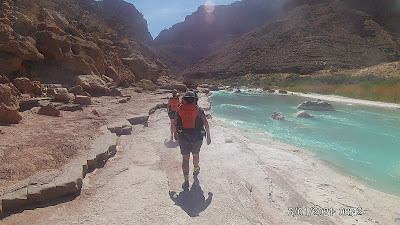Kathy taking a break from folding up our chairs and waiting for departure. Everything has to be loaded and unload each day. You need a good group of people to ensure the task is done as quickly as possible.
You can see in this photo Bob covers his legs with a sarong. We purchased ours from Canyoneers. They were worth every penny,
Again we meet other rafters along the river. These type of rafts are manual oaring and can take 14 days or more to complete their journey.
A storm develops ahead of us. We were lucky the rainfall was minimal. Storms miles away can have severe consequences in the river.
Last 3 days of our trip were extremely hot and you must keep cool to ensure you don't get heat stroke. In addition to pouring water on your body, you dip your hat and sarong and use the sarong to cover your arms and legs.
It feels very cold, but needed to be done.
Each name on the back of our preservers represents one of the rapids in the canyon. Horn is a number 10 rapid for difficulty. Although we were not splashed every time we rode a rapid, it was the piloting skills that ensured a successful trip.
Avoid rocks at all costs. They can flip a raft in seconds. Thankfully our pilots did a fantastic job to keep us safe throughout our trip.
Beginning of another hike up a river wash. Not sure why the guy is wearing is life preserver.
We finally arrive at our destination only to find out we have to swim under the boulder and climb up another slippery rock to reach another level. I decided that I will stay right here until the group starts back.
According to most estimates, the Grand Canyon is home to at least 80 big water rapids.



































